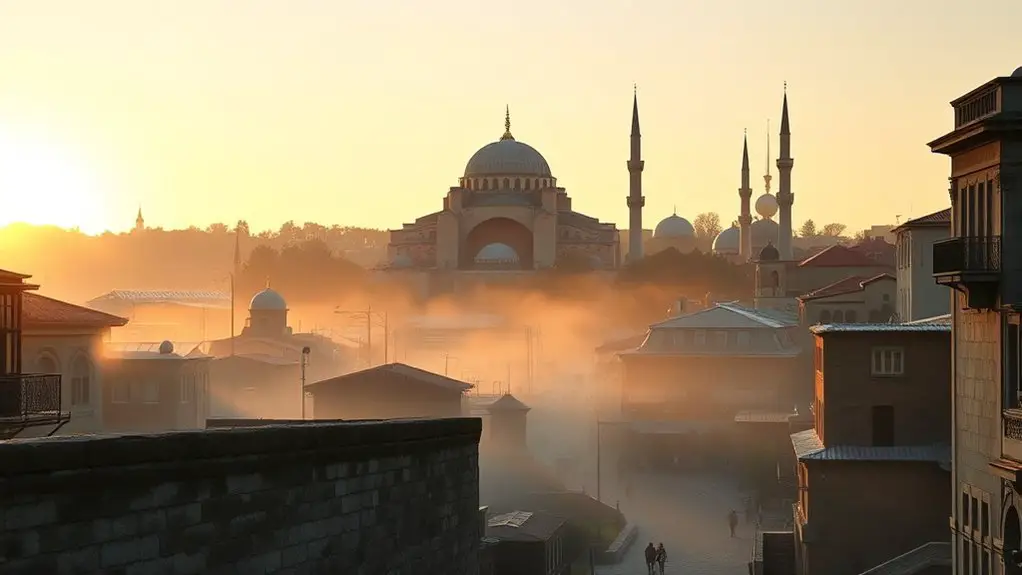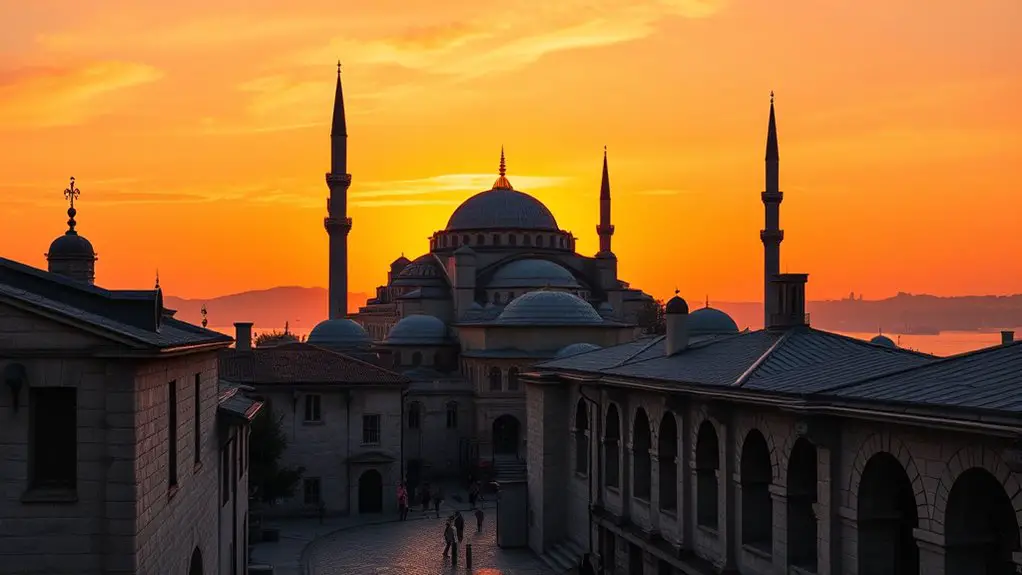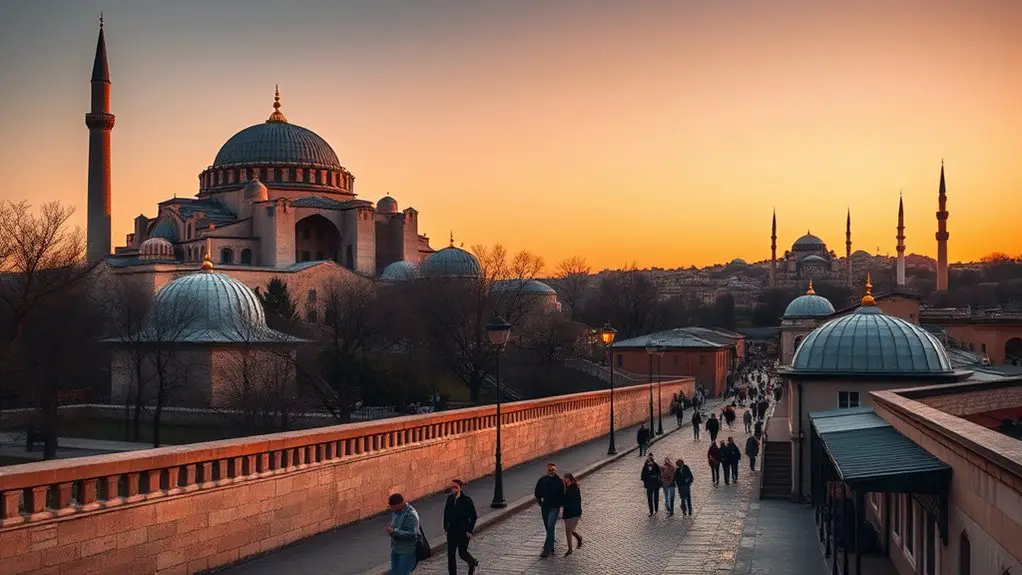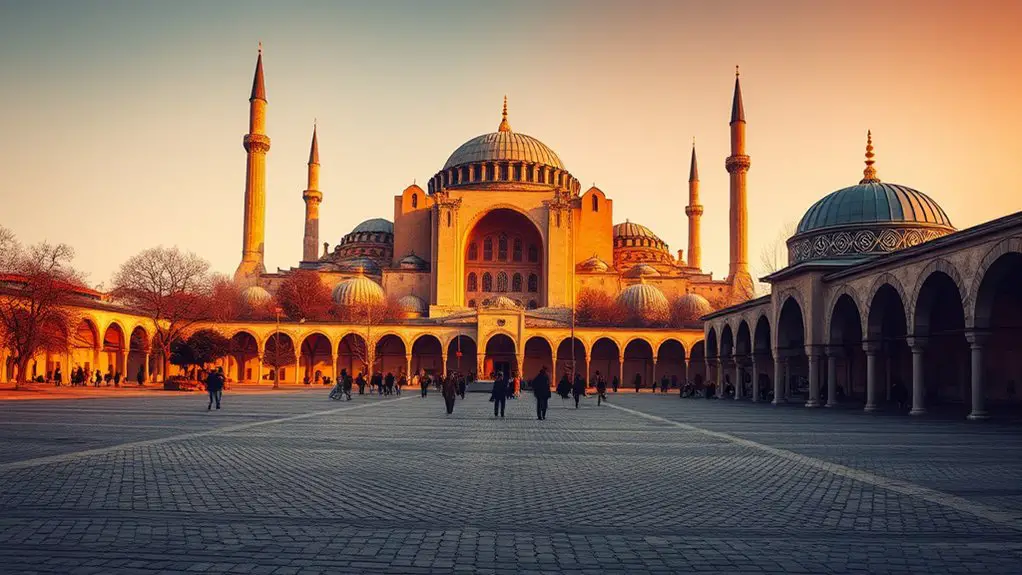Consider the striking contrast between the ancient Hagia Sophia and the majestic Blue Mosque, both standing in Sultanahmet. This area reflects centuries of historical shifts, from its origins as Byzantium to its pivotal role in the Ottoman Empire. Each architectural marvel tells a story of cultural convergence and transformation. What does this blend reveal about the evolution of Istanbul’s identity, and how does it continue to shape the district’s significance today?
Key Takeaways
- Sultanahmet’s origins date back to the 7th century BCE as a trade and military hub founded by settlers from Megara.
- The establishment of Constantinople in 330 AD marked the rise of the Byzantine Empire and its cultural significance.
- The Ottoman conquest in 1453 transformed the area, merging Byzantine and Islamic architectural elements into a distinct identity.
- Architectural innovations like Hagia Sophia and the Blue Mosque exemplify the blend of religious traditions and cultural exchanges in Sultanahmet.
- Today, Sultanahmet balances historical preservation with modern tourism, ensuring that its rich legacy continues for future generations.
The Foundations of Byzantium: a Glimpse Into the Past

The city of Byzantium, founded in the 7th century BCE, stands as a tribute to the strategic vision of its founders.
As you explore its Byzantine foundations, you’ll uncover how its location served as an essential crossroads for trade and military endeavors. Nestled between the Bosporus and the Sea of Marmara, Byzantium attracted various ancient settlements, each leaving a mark on its development.
The city’s original inhabitants, likely from Megara, recognized the advantages of controlling maritime routes, which shaped their early settlement patterns.
Byzantium’s fortifications and natural harbors enhanced its security and economic significance. Its founders understood that establishing a thriving hub required not just a defensible position but also access to crucial resources and trade networks.
This foresight laid the groundwork for what would eventually evolve into a major center of culture and power, foreshadowing the city’s prominent role in history.
Constantinople: The Rise of an Empire

As you explore the rise of Constantinople, you’ll uncover the strategic foundation that transformed it into a powerful empire.
The city’s architectural marvels, from the awe-inspiring Hagia Sophia to the imposing walls, reflect innovative engineering that defined an era.
Additionally, its cultural and religious significance laid the groundwork for a diverse society that shaped the course of history.
Foundation of Constantinople
Founded in 330 AD, Constantinople emerged as a strategic nexus bridging Europe and Asia, fundamentally altering the course of history. Its establishment marked the rise of the Byzantine Empire, which would leave a lasting legacy on culture, governance, and trade. The city’s strategic location facilitated control over key trade routes, fostering economic prosperity and cultural exchange.
| Feature | Description | Impact |
|---|---|---|
| Location | Positioned between two continents | Essential for trade control |
| Walls | Fortifications protecting the city | Guaranteed military strength |
| Infrastructure | Advanced roads and ports | Enhanced connectivity |
| Diversity | A melting pot of cultures | Promoted cultural exchange |
| Governance | Centralized power under one ruler | Strengthened political unity |
This foundation laid the groundwork for an empire that would influence civilizations for centuries.
Architectural Marvels and Innovations
While many cities throughout history have left their mark through impressive structures, Constantinople stands out for its architectural innovations that not only reflected its cultural diversity but also reinforced its strategic significance.
You’ll notice how various architectural styles, from Roman to Byzantine, converge within the city, showcasing a blend that’s unique. The use of domes and arches exemplifies innovative techniques that allowed for vast, open interiors, as seen in the Hagia Sophia.
This structure’s massive dome, in particular, pushed the boundaries of engineering, influencing countless buildings thereafter. In addition, intricate mosaics and detailed columns illustrate how artistry married functionality, creating a visual narrative that speaks to the empire’s grandeur.
As such, the architectural landscape of Constantinople serves as a symbol of its historical legacy.
Cultural and Religious Significance
The architectural wonders of Constantinople not only served practical purposes but also embodied the city’s rich cultural and religious significance.
As you explore its famous sites, you’ll notice how they reflect a blend of religious traditions, from the grandeur of Hagia Sophia, a symbol of Orthodox Christianity, to the vibrant call to prayer echoing from the Blue Mosque, representing Islam.
These structures facilitated cultural exchanges, making Constantinople a melting pot of ideas and beliefs. The harmonious coexistence of diverse faiths fostered a unique atmosphere, attracting scholars, artists, and traders.
This interplay of cultures enriched the city’s identity, leaving a lasting impact on its historical narrative. By understanding these elements, you gain deeper insights into the essence of Sultanahmet’s legacy.
The Great Transformation: From Byzantine to Ottoman

As the Byzantine Empire waned, the transformation of Sultanahmet into an Ottoman stronghold marked a pivotal shift in the region’s identity and architecture.
You can observe how the Ottoman expansion redefined the landscape, blending the remnants of Byzantine influence with new, assertive designs. The conquest of Constantinople in 1453 catalyzed this change, as the Ottomans sought to establish their dominance and cultural identity.
Ottoman expansion reshaped the landscape, merging Byzantine remnants with bold new designs following the pivotal conquest of Constantinople in 1453.
In Sultanahmet, you’ll notice how the Ottomans repurposed existing Byzantine structures, integrating features like domes and arches into their own architectural language.
This synthesis not only preserved historical elements but also heralded a new era of Islamic architecture that emphasized grandeur and scale. The shift was more than structural; it symbolized a profound cultural transformation, where the Ottoman Empire embraced its Byzantine roots while forging a distinct, powerful identity in the heart of a once-Greek city.
Architectural Wonders: The Hagia Sophia and Its Legacy
When you examine the Hagia Sophia, you can’t help but notice its groundbreaking architectural innovations that have influenced structures worldwide.
Its massive dome and intricate mosaics not only showcase Byzantine engineering prowess but also reflect the cultural shifts that occurred over centuries.
As you explore its legacy, you’ll see how this iconic building has continuously adapted to the changing tides of faith and society.
Architectural Design Innovations
Innovation in architectural design has always captivated those who step into the grandeur of the Hagia Sophia. Its design evolution showcases a masterful blend of Byzantine and Islamic influences, creating a unique architectural dialogue.
The massive dome, supported by pendentives, exemplifies structural advancements that allow for vast open spaces beneath. This innovative approach not only redefined the use of domes in religious buildings but also influenced many subsequent structures across the globe.
You can see how the interplay of light through the numerous windows enhances the ethereal atmosphere, a reflection of the architects’ foresight. Each element, from the intricate mosaics to the sweeping arches, reflects a deliberate intention to push architectural boundaries while remaining rooted in the spiritual essence of the space.
Cultural Significance Through Time
The architectural marvel of the Hagia Sophia not only showcases design innovations but also embodies a rich tapestry of cultural significance that has evolved over centuries.
As you explore its vast interiors, you’ll notice how it has served as a meeting point for cultural exchanges between East and West. Originally a Byzantine cathedral, its transformation into a mosque and later a museum reflects shifting historical narratives that resonate with diverse communities.
Each layer of decoration and architectural element tells a story of the people who worshipped and admired within its walls. The Hagia Sophia stands as a symbol of resilience, adapting through time while maintaining its status as a representation of unity, faith, and the enduring power of culture.
The Blue Mosque: A Symbol of Ottoman Grandeur
Majestic and intricate, the Blue Mosque stands as a tribute to Ottoman architectural prowess and cultural ambition. Built in the early 17th century, this iconic structure not only showcases the grandeur of Ottoman architecture but also embodies significant historical value. As you explore its stunning domes and minarets, you’ll appreciate how it symbolizes the empire’s aspirations during its zenith.
| Feature | Description | Significance |
|---|---|---|
| Dome Height | 43 meters | Represents the heavens |
| Minarets | Six towering structures | A sign of importance and power |
| Interior Tiles | Over 20,000 Iznik tiles | Illustrates artistic mastery |
The Blue Mosque’s harmonious design and intricate details invite visitors to reflect on its role as a spiritual and cultural landmark, marking a pivotal moment in the Ottoman Empire’s history.
Cultural Convergence: The Meeting Point of East and West
While wandering through Sultanahmet, you’ll notice how this historic district serves as a vibrant tapestry woven from the threads of diverse cultures, illustrating the profound intersection of East and West.
This cultural convergence manifests in various forms, reflecting a rich legacy of cultural exchange and artistic fusion.
- Architectural styles blend Byzantine and Ottoman influences.
- Culinary traditions showcase a mix of Eastern spices and Western flavors.
- Art exhibits reveal a synthesis of local and global techniques.
- Festivals celebrate both Islamic and secular traditions, fostering community.
Every corner you explore reveals layers of history that have shaped not just Sultanahmet, but the broader narrative of Istanbul.
This dynamic interplay between cultures enhances your experience, inviting you to appreciate the unique heritage that continues to thrive today.
In this way, Sultanahmet stands as a symbol of how diverse influences can coexist and enrich one another, creating a timeless dialogue between the East and West.
Sultanahmet Today: Preserving History in a Modern World
As you stroll through Sultanahmet today, you’ll find a delicate balance between preserving its historic essence and adapting to modern demands. Urban preservation efforts are evident in the meticulously maintained facades of iconic structures like the Hagia Sophia and the Blue Mosque, which stand as symbols of the area’s rich heritage.
Yet, as historical tourism thrives, the influx of visitors poses challenges; local businesses must evolve without sacrificing authenticity.
As tourism flourishes, local businesses face the challenge of evolving while preserving their authentic charm.
You’ll notice innovative approaches to maintaining this balance, such as guided tours that educate tourists while promoting respect for the cultural environment. Public spaces have been redesigned to accommodate both visitors and residents, fostering a sense of community amidst the bustling tourist activity.
Sultanahmet’s ability to honor its past while embracing the present isn’t just commendable—it’s essential for ensuring that future generations can experience this unique intersection of history and modernity.
Frequently Asked Questions
What Role Did Sultanahmet Play in the Silk Road Trade?
Sultanahmet played an essential role in the Silk Route, serving as a vibrant hub for trade.
You’d see merchants exchanging spices, textiles, and precious goods here, highlighting its trade importance.
Its strategic location linked Europe and Asia, facilitating cultural and economic exchanges that impacted the region’s development.
As you explore, you’ll notice how this bustling area shaped the trade dynamics and cultural interactions along one of history’s most significant trade routes.
How Has Tourism Impacted Sultanahmet’s Historical Sites?
Tourism has notably impacted Sultanahmet’s historical sites, enhancing their visibility and preservation.
You’ll notice that increased foot traffic has led to economic benefits, boosting local businesses and funding maintenance efforts.
However, the heavy influx of visitors can also strain these sites, risking wear and tear.
Balancing tourism effects with conservation is essential, as you explore the rich cultural heritage while ensuring these landmarks remain intact for future generations to appreciate.
Are There Any Local Legends Associated With Sultanahmet?
You’ll find that Sultanahmet’s local legends are a delightful mix of mystic tales and whimsical origins.
One of the most famous stories tells of a hidden treasure buried beneath the Hippodrome, guarded by a long-forgotten spirit.
As you stroll through the area, you can almost hear the whispers of ancient souls, reminding you that history isn’t just about dates and events; it’s also about the enchanting stories that breathe life into the stones.
What Challenges Does Sultanahmet Face in Preservation Efforts?
Sultanahmet faces significant challenges in preservation efforts, particularly regarding funding challenges and the application of effective restoration techniques.
You’ll notice that limited financial resources often hinder extensive projects, making it difficult to maintain the area’s historical integrity.
Furthermore, balancing modern urban development with conservation needs complicates efforts further.
Without adequate investment and innovative restoration methods, the site’s rich heritage risks deterioration, impacting both its cultural significance and tourism appeal.
How Do Residents Feel About Living Near Historical Sites?
Residents often feel a deep sense of pride living near historical sites, with about 75% expressing strong community sentiments towards cultural preservation.
They appreciate the rich heritage that attracts tourists, boosting local businesses.
However, there’s a tension; while they cherish the history, many worry about the commercialization overshadowing the authenticity of their neighborhood.
Balancing the vibrancy of tourism with the integrity of their cultural identity remains a constant challenge for the community.
Conclusion
As you stroll through Sultanahmet today, the echoes of its storied past resonate around you. You can’t help but wonder how the intricate designs of the Hagia Sophia and the majestic Blue Mosque have witnessed centuries of change. Each stone whispers secrets of empires and cultures that once thrived here. Will you uncover the hidden tales that linger in the air? The journey through this historical tapestry is just beginning, inviting you to explore its depths further.
